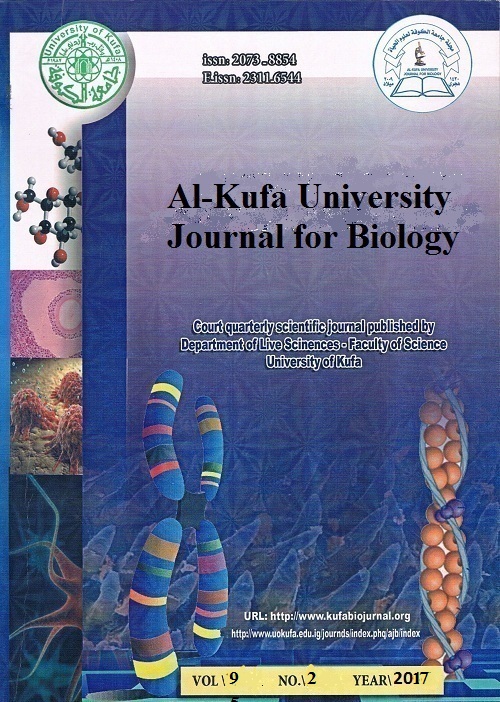Molecular identification of methicillin-resistance Staphylococcus aureus isolated from milk of breast infection woman in Diwanyia province.
DOI:
https://doi.org/10.36320/ajb/v9.i2.7596Keywords:
Staphylococcus-aureus, MRSA, PCRAbstract
Methicillin-resistance Staphylococcus aureus (MRSA) is the greatest important source of community-acquired infection in humans. The present study was carried out to use (PCR) assay as more specific molecular methods for recovering of methicillin resistant S.aureus (MRSA) isolates that isolated from milk of breast infection woman which collected from Diwanyia hospital . PCR assay was based on used specific primers that amplified of mecA gene in S.aureus isolates. The primers were designed in this study by using NCBI-Genbank data base (KM505042.1) and primer 3 plus primers design. The results of primary identification bacterial isolation were show 16 positive S.aureus isolates out of 50 milk samples. From those 5(31.25)were identification methicillin-antibiotic-resistant S. aureus (MRSA) using PCR assay The conclusion was to establish a fast and specific PCR tool for the detection of methicillin resistant S. aureus (MRSA)in human milk that may be major risk factor human health.
Downloads
References
Pauld. Stapleton and Peter W. Taylor. (2002). Methicillin resistance in Staphylococcus aureus. Sci Prog.; 85(Pt 1): 57–72.
Steven Y. C. Tonga, Joshua S. Davisa, Emily Eichenbergerb, Thomas L. Hollandband , Vance G. Fowler (2015). Staphylococcus aureus Infections: Epidemiology, Pathophysiology, Clinical Manifestations, and Management. Clin. Microbiol. vol. 28 no. 3 603-661.
Kikuchi K, Takahashi N, Piao C, Totsuka K, Nishida H, Uchiyama T. (2003)Molecular epidemiology of methicillin-resistant Staphylococcus aureus strains causing neonatal toxic shock syndrome-like exanthematous disease in neonatal and perinatal wards. J Clin Microbiol.;41:3001–6.
Borderline susceptibility to methicillin in Staphylococcus aureus: a new mechanism of resistance? Montanari MP, Massidda O, Mingoia M, Varaldo PE Microb Drug Resist. (1996) Summer; 2(2):257-60.
Hackbarth CJ, Kocagoz T, Kocagoz S. (1995).Point mutations in Staphylococcus aureus -------- PBP 2gene affect penicillin-binding kinetics and are associated with resistance. Chambers HF. Antimicrob Agents Chemother Jan; 39(1):103-6.
Eady EA, Cove JH(2003). Staphylococcal resistance revisited: community-acquired methicillin resistant Staphylococcus aureus-an emerging problem for the management of skin and soft tissue infections. Curr Opin Infect Dis.;16:103–124.
Almeida JAG, Novak FR, Almeida CHG(1998). Avaliação parcial da flora microbiana do leite humano ordenhado no IMIP. Revista do IMIP 3: 13-16.
FR Novak , JAG Almeida, MB Warnken, BT Ferreira-Carvalho, and AN Hagler (2000). Methicillin-resistant Staphylococcus aureus in Human Milk. Vol. 95(1): 29-33.
Saiman L, O’Keefe M, Graham PLIII, Wu F, Said-Salim B, Kreiswirth B(2003), Hospital transmission of community-acquired methicillin-resistant Staphylococcus aureus among postpartum women.Clin Infect Dis.;37:1313–9.
Laibl VR, Sheffield JS, Roberts S, McIntire DD, Trevino S, Wendel GDJr(2005). Clinical presentation of community-acquired methicillin-resistant Staphylococcus aureus in pregnancy.Obstet Gynecol.;106:461–5.
Holt, J. G.; Krieg, N. R.; Sneath, P. H. A.; Stanley, J. T.; and Williams, S. T. (1994). -Bergeys Manual of Determinative Bacteriology. 9th ed., Wiliams and Wilkins, ------Baltimore, USA
MacFaddin, J. F. (2000). Biochemical Tests for Identification of Medical Bacteria ------3rd ed. Lippincott Williams and Wilkins, USA.
Stukus, P. E. (1997) . Investigating microbiology. Harcout Brace and Companies.
Zahan NA1, Hossain MA, Musa AK, Shamsuzzaman AK, Mahamud MC, Mamun AA, Paul SK, Ahmed S, Sumona AA, Begum Z, Alam M, Yusuf MA, Uddin MS. (2009). PCR for mecA gene of methicillin resistant Staphylococcus aureus. Mymensingh Med J. Jan;18(1):21-6.
Pavani Reddy,* Chao Qi,* Teresa Zembower,* Gary A. Noskin,* and Maureen ------Bolon*( 2007). Postpartum Mastitis and Community acquired Methicillin-resistant ----Staphylococcus aureus . Emerging Infectious Diseases • www.cdc.gov/eid • Vol. 13, No. -----2, February .
Naimi TS, LeDell KH, Como-Sabetti K, Borchardt SM, Boxrud DJ, Etienne J, et al., (2003). Comparison of community- and health care-associated methicillin-resistant Staphylococcus aureus infection. JAMA. ;290:2976–84.
Abazar Pournajaf1, Abdollah Ardebili1,2*, Leyla Goudarzi3, Mahmoud Khodabandeh4, Tahmineh Narimani5, Hassan Abbaszadeh ( 2013).PCR-based -identification of methicillin-resistant Staphylococcus aureus strains and their antibiotic-resistance profiles. doi:10.12980/APJTB.4.2014C423
Huletsky, A.; Gagnon, F.; and Rossbach, V. (2002). Less than 1-h detection of methicillin-resistant S. aureus directly from nasal swabs by real- time polymerase chain reaction (PCR) using the smart cycler. J. Clin. Microbiol. Infect. Dis. 8 (1): 85.
Downloads
Published
How to Cite
Issue
Section
License
Copyright (c) 2017 Rana Masheel Salim

This work is licensed under a Creative Commons Attribution 4.0 International License.
which allows users to copy, create extracts, abstracts, and new works from the Article, alter and revise the Article, and make commercial use of the Article (including reuse and/or resale of the Article by commercial entities), provided the user gives appropriate credit (with a link to the formal publication through the relevant DOI), provides a link to the license, indicates if changes were made and the licensor is not represented as endorsing the use made of the work.












